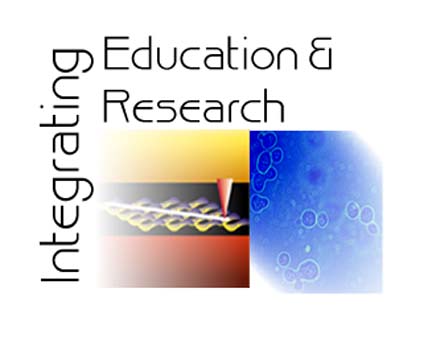

This program provides assistance to KSU science faculty who wish to transfer the content and process of their research activities to lower division undergraduate courses and teacher preparation or enhancement programs. Building upon knowledge and experiences from well-established research-to-instruction examples, the Program to Integrate Education and Research provides planning and implementation supports.
Emphasis on Pre-service Teacher Education and Professional Development for Current Teachers
Successful Models of Integration
The Math-Science Elementary Education Project
Program Assistance from Research Scientists
The abilities and interests of university-level science students depend in a large part on their experiences in elementary and secondary schools --- and the quality of that early education is directly related to the skills and knowledge of teachers. Hands-on involvement in science research and an introduction to contemporary ideas in the sciences helps K-12 teachers develop understanding of the nature and process of science, so that they can adequately prepare their students for study at the post-secondary level.
The focus of the Program to Integrate Education and Research is introducing research scientists to teaching strategies and methods that convert research activity to group teaching and to developing student-centered instructional materials, primarily for pre-service and in-service teachers. However, courses for the general undergraduate student are also considered. The program will continue to build on the models which were instrumental in the NSF Recognition Award for Integrating Research and Education. These models included the development of instructional materials, collaborative efforts between science and education faculty, and significant contributions from pre-college teachers.
Visual Quantum Mechanics brings contemporary physics research ideas to present and future teachers by emphasizing how quantum science affects everyday life.
Return to top of page
The Mathematics-Science Elementary Education Project, supported by the NSF, developed a model research-based pre-service education program to prepare elementary teachers for enhanced science, math, and technology teaching. Collaborating scientists, education specialists, and school practitioners integrated research experiences with methodology for teaching science to elementary students. Faculty participants developed or modified numerous science and mathematics courses specifically for pre-service elementary teachers.
A capstone course on ecology took place primarily on the Konza Prairie Research Natural Area. This experience enables the students to apply scientific principles in a research setting.
Return to top of page
The Genetics Education Networking & Enhancement project, developed with support from the National Science Foundation and the Howard Hughes Medical Institute, helps teachers with diverse backgrounds and teaching responsibilities acquire the knowledge and materials needed to teach technical, quantitative, interdisciplinary science by using experimental procedures from current genetics research.
The GENE network of teachers, scientists and education specialists have developed research-oriented, hands-on laboratories directly related to science content. The activities use living organisms as an effective means to both increase science learning and to instill enthusiasm for science in both teachers and students.
Return to top of page
The program encourages faculty to develop ways to make their research in science, math and engineering accessible to future and present teachers and to beginning university students.
Each project should extend the general approach and concepts for which the award was received. The efforts underway at present include:
• Undergraduate student understanding of phenomena occurring at the atomic level, on surfaces of materials is being investigated. This research is the first step toward developing instructional materials for a topic normally reserved for graduate students.
• First year physics undergraduates are interviewing faculty members and creating Web pages about their research. The students are, thus, translating the research into their own words.
• The development of instructional materials which relates quantum mechanics to modern technology is continuing. (Supported by additional funding from NSF.)
• Future biology teachers will have the opportunity to participate in biology research, science education research and/or curriculum development. (Supported by the Howard Hughes Medical Institute.)
• A course will be developed to introduce biology and pre-professional students to the applications of quantum physics to modern medical diagnosis. (Supported by the Howard Hughes Medical Institute.)
• Non-science students are being given opportunities to participate in scientific or science education research.
• A group of rural high school and middle school teachers are participating in workshops on applications of the laser and of quantum physics. (Supported by the Eisenhower Professional Development Program.)
The Program for Integrating Education and Research is interested in these and other ideas which will communicate research at KSU to a general audience. Priority is given to efforts which involve present and future school teachers.
Return to top of page
The Program to Integrate Education and Research is supported by one of only ten competitive grants awarded nationally by the National Science Foundation in its first-ever Recognition Awards for the Integration of Research and Education. These awards reflect a top priority for the National Science Foundation, name, to "stimulate new thinking at colleges and universities on how to better link research and education."
The Kansas State University program to Integrate Education and Research is unique in its focus on enhancing both the education of in-service and pre-service K-12 teachers, and in facilitating the development of new courses for undergraduates who are not majoring in science.
Return to top of page
Dean Zollman, Professor of Physics, is Director of the Program to Integrate Education and Research. Dr. Zollman heads the KSU Physics Education Group and is the 1996 Carnegie Foundation's National Research University Professor of the Year.
Project staff also include: Michael Thoresen, Postdoctoral Project Coordinator; Kim Coy, Administrative Assistant, and Kastro Hamed, Graduate Research Assistant.
Return to top of page
Fax: 785-532-7167
Voice: 785-532-1612
The program is supported by the National Science Foundation under award 9620042. Opinions expressed are those of the Program staff at Kansas State University and are not necessarily those of the National Science Foundation
Recognition Award for Integrating Research and
Education
Physics Education Group Home Page